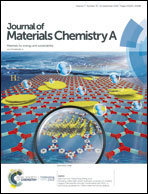Modulating the surface segregation of PdCuRu nanocrystals for enhanced all-pH hydrogen evolution electrocatalysis†
Abstract
Core–shell architecture coupled with rational surface engineering constitutes an efficient strategy for promoting electrocatalysis on multimetallic nanocrystals via the optimization of composition, facets and coordination environment. Here, by leveraging controlled surface segregation, we realize core–shell formation with systematic tuning of surface composition on well-defined PdCuRu nanocrystals. When applied for the hydrogen evolution reaction (HER), we established a direct correlation between surface composition and activity. In particular, PdCuRu catalysts with a Pd-rich surface achieved an overpotential of 31 mV at a current density of 10 mA cm−2 and a low Tafel slope of 52 mV dec−1 in an alkaline electrolyte, considerably enhanced relative to control PdCuRu/C catalysts with other surface compositions and even exceeding those of state-of-the-art Pt/C. Similar trends were also observed in both neutral and acid electrolytes. We deduce that, in this catalytic system, the enhanced electrocatalysis originates from the strain effect rather than the bifunctional mechanism. The present study builds a bridge between surface engineering and HER performance, and opens up new material designs for surface Pd-rich core–shell nanostructures for the purpose of improving HER catalytic activity and stability at all pH values.



 Please wait while we load your content...
Please wait while we load your content...